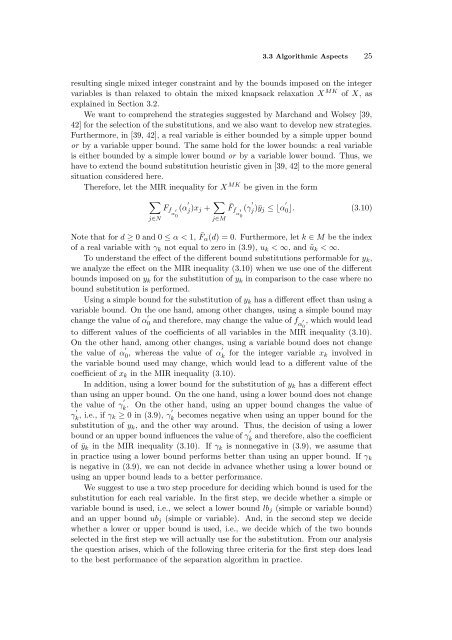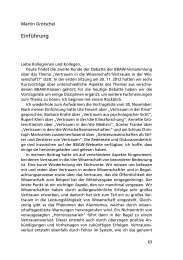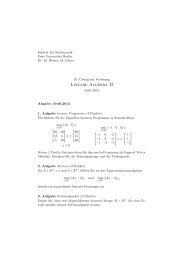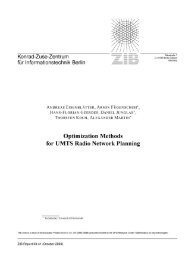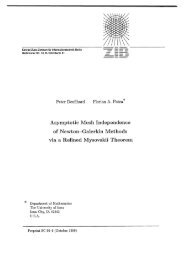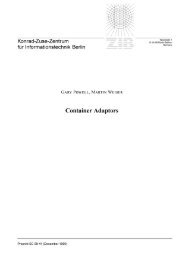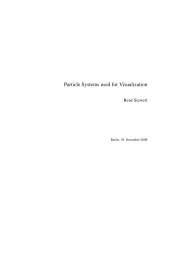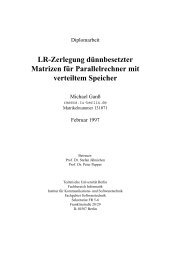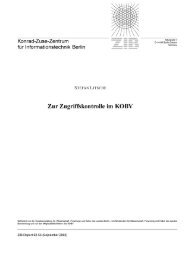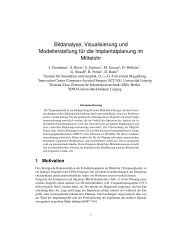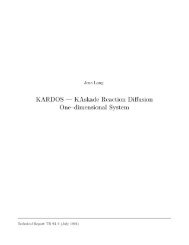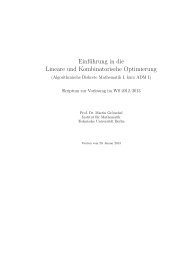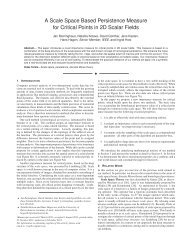Implementation of Cutting Plane Separators for Mixed Integer ... - ZIB
Implementation of Cutting Plane Separators for Mixed Integer ... - ZIB
Implementation of Cutting Plane Separators for Mixed Integer ... - ZIB
Create successful ePaper yourself
Turn your PDF publications into a flip-book with our unique Google optimized e-Paper software.
3.3 Algorithmic Aspects 25<br />
resulting single mixed integer constraint and by the bounds imposed on the integer<br />
variables is than relaxed to obtain the mixed knapsack relaxation X MK <strong>of</strong> X, as<br />
explained in Section 3.2.<br />
We want to comprehend the strategies suggested by Marchand and Wolsey [39,<br />
42] <strong>for</strong> the selection <strong>of</strong> the substitutions, and we also want to develop new strategies.<br />
Furthermore, in [39, 42], a real variable is either bounded by a simple upper bound<br />
or by a variable upper bound. The same hold <strong>for</strong> the lower bounds: a real variable<br />
is either bounded by a simple lower bound or by a variable lower bound. Thus, we<br />
have to extend the bound substitution heuristic given in [39, 42] to the more general<br />
situation considered here.<br />
There<strong>for</strong>e, let the MIR inequality <strong>for</strong> X MK be given in the <strong>for</strong>m<br />
<br />
j∈N<br />
Ff ′ (α<br />
α<br />
0<br />
′<br />
j)xj + <br />
j∈M<br />
¯Ff ′ (γ<br />
α<br />
0<br />
′<br />
j)¯yj ≤ ⌊α ′<br />
0⌋. (3.10)<br />
Note that <strong>for</strong> d ≥ 0 and 0 ≤ α < 1, ¯ Fα(d) = 0. Furthermore, let k ∈ M be the index<br />
<strong>of</strong> a real variable with γk not equal to zero in (3.9), uk < ∞, and ũk < ∞.<br />
To understand the effect <strong>of</strong> the different bound substitutions per<strong>for</strong>mable <strong>for</strong> yk,<br />
we analyze the effect on the MIR inequality (3.10) when we use one <strong>of</strong> the different<br />
bounds imposed on yk <strong>for</strong> the substitution <strong>of</strong> yk in comparison to the case where no<br />
bound substitution is per<strong>for</strong>med.<br />
Using a simple bound <strong>for</strong> the substitution <strong>of</strong> yk has a different effect than using a<br />
variable bound. On the one hand, among other changes, using a simple bound may<br />
change the value <strong>of</strong> α ′<br />
0 and there<strong>for</strong>e, may change the value <strong>of</strong> fα ′ , which would lead<br />
0<br />
to different values <strong>of</strong> the coefficients <strong>of</strong> all variables in the MIR inequality (3.10).<br />
On the other hand, among other changes, using a variable bound does not change<br />
the value <strong>of</strong> α ′<br />
0<br />
, whereas the value <strong>of</strong> α′<br />
k <strong>for</strong> the integer variable xk involved in<br />
the variable bound used may change, which would lead to a different value <strong>of</strong> the<br />
coefficient <strong>of</strong> xk in the MIR inequality (3.10).<br />
In addition, using a lower bound <strong>for</strong> the substitution <strong>of</strong> yk has a different effect<br />
than using an upper bound. On the one hand, using a lower bound does not change<br />
the value <strong>of</strong> γ ′<br />
k . On the other hand, using an upper bound changes the value <strong>of</strong><br />
γ ′<br />
k , i.e., if γk ≥ 0 in (3.9), γ ′<br />
k becomes negative when using an upper bound <strong>for</strong> the<br />
substitution <strong>of</strong> yk, and the other way around. Thus, the decision <strong>of</strong> using a lower<br />
bound or an upper bound influences the value <strong>of</strong> γ ′<br />
k and there<strong>for</strong>e, also the coefficient<br />
<strong>of</strong> ¯yk in the MIR inequality (3.10). If γk is nonnegative in (3.9), we assume that<br />
in practice using a lower bound per<strong>for</strong>ms better than using an upper bound. If γk<br />
is negative in (3.9), we can not decide in advance whether using a lower bound or<br />
using an upper bound leads to a better per<strong>for</strong>mance.<br />
We suggest to use a two step procedure <strong>for</strong> deciding which bound is used <strong>for</strong> the<br />
substitution <strong>for</strong> each real variable. In the first step, we decide whether a simple or<br />
variable bound is used, i.e., we select a lower bound lbj (simple or variable bound)<br />
and an upper bound ubj (simple or variable). And, in the second step we decide<br />
whether a lower or upper bound is used, i.e., we decide which <strong>of</strong> the two bounds<br />
selected in the first step we will actually use <strong>for</strong> the substitution. From our analysis<br />
the question arises, which <strong>of</strong> the following three criteria <strong>for</strong> the first step does lead<br />
to the best per<strong>for</strong>mance <strong>of</strong> the separation algorithm in practice.


